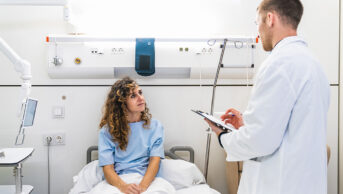
IAN HOOTON / SCIENCE PHOTO LIBRARY
NHS hospital staff have been exposed to high levels of nitrous oxide, in one case 12 times the UK workplace exposure limit, an investigation by The Pharmaceutical Journal has revealed.
The data, obtained under the Freedom of Information (FOI) Act, reveals that 26 of the 131 hospital trusts who responded (20%) had recorded that staff were exposed to levels that exceeded workplace exposure limits, defined by regulators as an average concentration above 100 parts per million (ppm).
In one hospital trust, levels were 12 times workplace exposure limits and five trusts found staff were exposed to levels that were 6 times more than the limit.
Responses also showed that 8 trusts (6%) had recently suspended Entonox, a mixture of nitrous oxide and air, either temporarily or permanently, and others said they had stopped supplying piped nitrous oxide completely.
However, this may underestimate the problem, because only 67 of respondents (51%) said they had carried out personal sampling of staff at the time of the FOI request to assess occupational exposure to nitrous oxide.
The FOI results also showed that 12 trusts (9%) that planned to carry out sampling were in the process of doing it or were waiting for the results; however, 38 trusts (29%) had not carried out any personal sampling at all.
Staff working regularly in hospital environments where high exposure is more likely, such as maternity wards, may be at risk of vitamin B12 deficiency caused by exposure to nitrous oxide. Research has also suggested that prolonged exposure to nitrous oxide could be linked with spontaneous abortions, congenital abnormalities and reduced rates of fertility.
Currently, the Health and Safety Executive (HSE) recommends that nitrous oxide concentrations averaged over eight hours do not exceed 100ppm and, after several incidents in trusts, NHS England published guidance in March 2023 on minimising the exposure to nitrous oxide in healthcare settings, although did not specifically recommend personal sampling of staff.
A spokesperson for the HSE said it was “vital” that exposure risks to staff at maternity wards were “properly managed”.
“We are aware that there have been issues with controlling exposure to nitrous oxide at a number of NHS maternity units and any specific complaints about this have been followed up, as will any others,” they said.
“Where it is necessary to use nitrous oxide, employers are required to ensure that exposure does not exceed the workplace exposure limits and that compliance with ‘Control of Substances Hazardous to Health 2002‘ (COSHH) is achieved.”
Laura Stevenson, associate chief pharmacist in aseptic services at King’s College Hospital NHS Foundation Trust, said the problem was that the risk is only just being assessed. “Women are using this Entonox, the staff are in the area, and they breathe it out in the room.
“When you speak to the midwives, they have never heard that this is a worry,” she added.
“[But] it’s not something that’s done on their induction, it’s not something that health and safety even really knew about… that’s the biggest concern on my end is that people aren’t [being] told about it.”
NHS England declined to comment on the figures.
You may also be interested in

Only 15% of NHS trusts meet emergency department pharmacy support standards, investigation finds

Hospitals should review pharmacy support in emergency departments, says health safety investigation body
